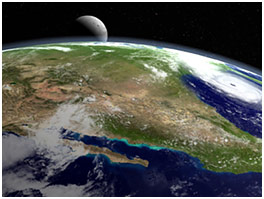(PhysOrg.com) — The Chandler Wobble is a small variation in the rotation of the Earth on its axis. It has been known for some time that the phase of the Chandler Wobble jumped by 180 degrees in the 1920s, but a new study by scientists at the Russian Academy of Sciences has found that the same thing also happened in 1850 and 2005. But no one knows why.
Any sphere that is not perfectly spherical has a slight wobble when it spins, rather like the effect you see as a spinning top is slowing down. The Earth’s wobble was discovered in 1891 by an American astronomer called Seth Carlo Chandler, and is named after him. The Chandler Wobble is one of the main components of the movement of the Earth’s axis of rotation relative to the surface of the Earth. Because the axis passes through the polar regions, this motion is also called Polar Motion.
The amplitude and phase of the Chandler Wobble change over time, which is widely believed to be caused largely by pressure fluctuations at the bottom of the oceans. The pressure changes result from ocean circulation currents, and variations in temperature and salinity. This theory explains small changes in phase and amplitude, but in the 1920s the Chandler Wobble phase suddenly jumped by 180 degrees, which cannot be explained by gradual variations in pressure.
Scientists working at the Central Astronomical Observatory in Pulkovo near St Petersburg recently analyzed all the data on the Earth’s rotation provided by the IERS (International Earth Rotation and Reference Systems service). The period of available data covered the last 163 years.
The study looked for variations in the amplitude and phase of the Chandler Wobble. The results showed that the phase and amplitude often change by small amounts, but the scientists also discovered there were two other occasions when the phase jumped by 180 degrees: in 1850, and in 2005. A deep decrease in amplitude coincided with each phase jump.
The scientists, Zinovy Malkin and Natalia Miller were studying the anomalies in the Earth’s rotation, especially as seen by the moving axis at the poles, because understanding these anomalies could help us understand changes in the Earth’s surface and interior and in the atmosphere and oceans. They used several methods of analysis to ensure their results were reliable, but they were not able to explain the reasons for the sudden dramatic changes in phase and amplitude.
More information: Chandler wobble: two more large phase jumps revealed, http://arxiv.org/abs/0908.3732

